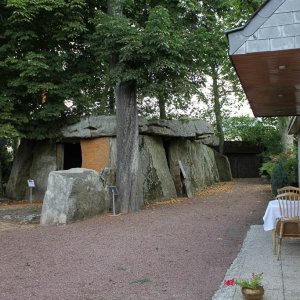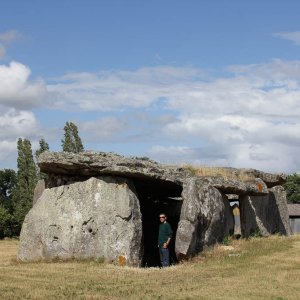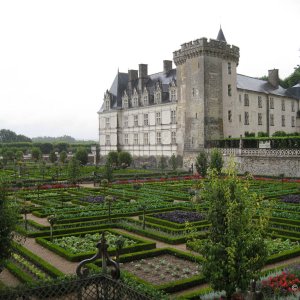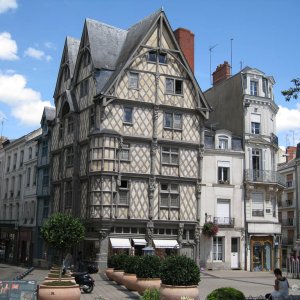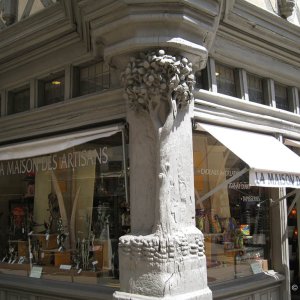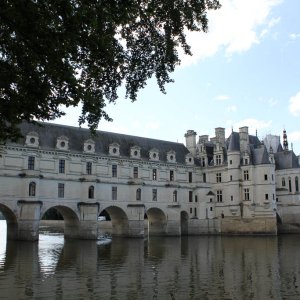Pauline
Forums Admin
This trip report was original posted on my blog.
In July 2010 we did a short trip to France – five nights in the Loire Valley followed by four nights in Normandy. We are currently living in England, so flew from Bristol Airport to Paris, picked up a rental car and drove four hours to the Loire Valley, west of Tours. We stayed in a vacation rental (gite) in the countryside north of the Loire River. It is flat in this part of the country, but there were beautiful woods and fields of sunflowers. The towns nearby were not very interesting – we needed to drive about 30+ minutes to the lively towns on the river. The closest town on the river is Saumur and it is an hour’s drive east to Tours or west to Angers.
The days are longer in France than in England. The “0” meridian line, which sets Greenwich Mean Time, passes through the Loire, but France is Greenwich +1, so that 9pm in the Loire is like 8pm in England. The summer days are long – it was light until after 10pm.
I was a bit wary of traveling in the high summer. Our first two days were hot, a little too hot for me, but after that it cooled and we even had rain one day. I was also worried about how crowded things would be in high tourist season. The only places with real crowds were the main tourist sights like Amboise and Chenonceau in the Loire, and Bayeux in Normandy.

Steve walking along the river in Chinon
Chinon. South of the Loire, on the Vienne River. We had a lovely lunch in the main square sitting outside under the trees. After lunch we explored the town and climbed up to the chateau, but it was closed for renovation.
On our first day out in France, after parking in Chinon, I stepped in dog shit. I didn’t just step in it, I mushed it into my shoes and sprayed it up my pants (trousers) leg. I had to use the power sprayer at the gite to get it off my shoe. “Welcome to France” and I kept a careful look where I was stepping after that.
Fontevraud Abbey. Historic abbey not far from Chinon, built in the 1100s. The English King Henry II and Eleanor of Aquitaine, along with their son Richard the Lionheart, are buried here (there is some doubt that their remains are still here, but they were originally buried here). The abbey was used as a prison in the first half of the 1900s and was featured in Jean Genet’s book “The Miracle of the Rose”. The abbey and the grounds are beautiful – I really enjoyed seeing this.
There was a modern art installation throughout the abbey that was supposed to enhance the experience by giving a multi-media interpretation of life there, but it was just annoying – a neon sign in the dining hall, in the Hollywood sign format, with “HolyFood”, loud speakers broadcasting in the abbey grounds, looping a recording in English, saying “time for lunch”. That type of thing.

Fontevraud Abbey
Amboise Chateau and Leonardo da Vinci House. It was a bit of a drive from our vacation rental to Amboise, but we took the road along the river and drove through part of Tours with no problems. It was a pretty drive but in my mind I had pictured wall-to-wall chateaux along a beautiful shining river, but instead you don’t see much of the river from the road and you only see a chateau every now and then.
Amboise is busy town with lots of tourists. We had a great lunch at a restaurant chosen at random, then went to the chateau. From the grounds of the chateau you get beautiful views over Amboise and the Loire River. Leonardo da Vinci lived in Amboise at the end of his life. He was buried in 1519 in St Hubert Chapel on the grounds of the chateau.
We headed into the chateau to tour through the rooms. This was my first chateau and already I was bored. How many different bedrooms do I need to see? I really wanted to see Amboise, and I liked the town, but plodding through the chateau looking at rooms was painful.
It was a 15 minute walk from the chateau to Leonardo’s house. We should have skipped this. The house was crowded but we joined the crowds and looked at a few rooms. It is exciting to think that Leonardo da Vinci lived here, but I felt more of a connection with him when we visited Vinci, a small town in Italy near Florence, years ago (Leonardo “from Vinci”).

St Hubert Chapel, built in the late 1400s, on the grounds of the Amboise Chateau.
Chateau Chenonceau. This is the best known chateau and is not far from Amboise. We purchased a chateau pass for Amboise Chateau, the Leonardo House and Cenonceau (from the tourist office in Amboise) and saw all on the same day. Cenonceau is beautiful but again it was crowded so we looked at a few rooms then wandered around the gardens.
Saumur. This town was a 30 minute drive from Les Mortiers. It sits on the south bank of the Loire River and has an impressive chateau overlooking the town. The central part of town is full of shops, cafes and restaurants. We never managed to be here during shopping hours because we always seemed to be heading off somewhere for the day, but it looked like it would be a nice town to visit. We walked around one evening after the shops were closed and had dinner there.
The Apocalypse Tapestry at the Angers Chateau. In France I like the small cities, like Aix, Avignon and now Angers. Paris can feel overwhelming but these smaller cities are fun and manageable. We walked around the two historic sections, one on each side of the river. There are wonderful medieval timber-framed houses. We looked at Saint Martin’s Collegiate Church (recently restored, parts date back to the 900s) and the main Cathedral.
We were in Angers for one thing – to see the Apocalypse Tapestry at the Angers Chateau – and it was well worth the trip. This tapestry is 103 meters long (338 feet – almost the length of an American football field). It was made in the 11th century (commissioned by Louis I, Duke of Anjou and brother of King Charles V) and tells the story of the Apocalypse according to St John from the Book of Revelations in the Bible. During the French Revolution the tapestry was cut up and used for other things, but in the mid-19th century the parts were brought back together and it was restored.
The tapestry is displayed in the chateau in a room built for it. The tapestry is in good shape and is very detailed with wonderful scenes of the end of the world, with many freaky-looking devils, and the coming of a New Jerusalem. You need at least an hour to have a good look at all the scenes.

A medieval timber-framed building in Angers.
Chateau Villandry. This is another popular chateau and was enjoyable to visit because the main feature is the gardens (so you are not nose-to-tail walking through an overly furnished house). It is in a small village with a line of restaurants. We chose a nice looking one in a hotel, had a lovely lunch on a rainy day, then toured the chateau when the rain stopped. The gardens are beautiful and we really enjoyed our walk through them.

The gardens at Villandry.
Neolithic Dolmens. I love ancient stones. We are surrounded by them where we are living in England – stone circles, standing stones, hill forts, long barrows and dolmen (burial tombs). We seek out ancient stones wherever we go and until this trip, the best dolmen we have seen is Poulnabrone in Country Clare, in Ireland. But Poulnabrone is nothing compared to the dolmens we saw near Saumur (the Loire Valley Eyewitness Travel Guide told us about the dolmen in this area).
Dolmen de la Madeleine is in a field on the edge of the small town of Gennes, west of Saumur. We were driving along looking for it but could not find it – there were no signs. We turned around and headed back towards Gennes thinking we must have missed it, came around a corner and WOW!! – there it was in a field. This thing is huge. At one time someone ran a bakery inside the dolmen – you can see the remains of the bakery ovens. This is not on anyone’s “must see” list and we were the only ones there, which was nice.
From Gennes we drove into Saumur, then out to the suburb of Bagneux. We were not sure where the dolmen was located but we found signs pointing the way. The dolmen is in the backyard of a cafe. Since it has been there for thousands of years, the city was built around the dolmen. We parked on a narrow street and went to a gate with a sign for the dolmen, rang the bell, paid the small entrance fee, and were let into the backyard. This dolmen was even bigger than Madeleine and seeing it in a backyard, surrounded by houses, is different from your usual dolman out on a hilltop somewhere dramatic. It was fantastic. The owner had provided posters with good historic information.

Dolmen de la Madeleine
Pays de la Loire - Bagneux Dolmen
Pays de la Loire - Fontevraud Abbey
In July 2010 we did a short trip to France – five nights in the Loire Valley followed by four nights in Normandy. We are currently living in England, so flew from Bristol Airport to Paris, picked up a rental car and drove four hours to the Loire Valley, west of Tours. We stayed in a vacation rental (gite) in the countryside north of the Loire River. It is flat in this part of the country, but there were beautiful woods and fields of sunflowers. The towns nearby were not very interesting – we needed to drive about 30+ minutes to the lively towns on the river. The closest town on the river is Saumur and it is an hour’s drive east to Tours or west to Angers.
The days are longer in France than in England. The “0” meridian line, which sets Greenwich Mean Time, passes through the Loire, but France is Greenwich +1, so that 9pm in the Loire is like 8pm in England. The summer days are long – it was light until after 10pm.
I was a bit wary of traveling in the high summer. Our first two days were hot, a little too hot for me, but after that it cooled and we even had rain one day. I was also worried about how crowded things would be in high tourist season. The only places with real crowds were the main tourist sights like Amboise and Chenonceau in the Loire, and Bayeux in Normandy.
Steve walking along the river in Chinon
Our Quick Tour of the Loire Valley
Sunday Market in Langeais. A pretty town on the river with a chateau and lively cafes and restaurants. The market was good, with lots of local produce. We did not go into the chateau.Chinon. South of the Loire, on the Vienne River. We had a lovely lunch in the main square sitting outside under the trees. After lunch we explored the town and climbed up to the chateau, but it was closed for renovation.
On our first day out in France, after parking in Chinon, I stepped in dog shit. I didn’t just step in it, I mushed it into my shoes and sprayed it up my pants (trousers) leg. I had to use the power sprayer at the gite to get it off my shoe. “Welcome to France” and I kept a careful look where I was stepping after that.
Fontevraud Abbey. Historic abbey not far from Chinon, built in the 1100s. The English King Henry II and Eleanor of Aquitaine, along with their son Richard the Lionheart, are buried here (there is some doubt that their remains are still here, but they were originally buried here). The abbey was used as a prison in the first half of the 1900s and was featured in Jean Genet’s book “The Miracle of the Rose”. The abbey and the grounds are beautiful – I really enjoyed seeing this.
There was a modern art installation throughout the abbey that was supposed to enhance the experience by giving a multi-media interpretation of life there, but it was just annoying – a neon sign in the dining hall, in the Hollywood sign format, with “HolyFood”, loud speakers broadcasting in the abbey grounds, looping a recording in English, saying “time for lunch”. That type of thing.
Fontevraud Abbey
Amboise Chateau and Leonardo da Vinci House. It was a bit of a drive from our vacation rental to Amboise, but we took the road along the river and drove through part of Tours with no problems. It was a pretty drive but in my mind I had pictured wall-to-wall chateaux along a beautiful shining river, but instead you don’t see much of the river from the road and you only see a chateau every now and then.
Amboise is busy town with lots of tourists. We had a great lunch at a restaurant chosen at random, then went to the chateau. From the grounds of the chateau you get beautiful views over Amboise and the Loire River. Leonardo da Vinci lived in Amboise at the end of his life. He was buried in 1519 in St Hubert Chapel on the grounds of the chateau.
We headed into the chateau to tour through the rooms. This was my first chateau and already I was bored. How many different bedrooms do I need to see? I really wanted to see Amboise, and I liked the town, but plodding through the chateau looking at rooms was painful.
It was a 15 minute walk from the chateau to Leonardo’s house. We should have skipped this. The house was crowded but we joined the crowds and looked at a few rooms. It is exciting to think that Leonardo da Vinci lived here, but I felt more of a connection with him when we visited Vinci, a small town in Italy near Florence, years ago (Leonardo “from Vinci”).
St Hubert Chapel, built in the late 1400s, on the grounds of the Amboise Chateau.
Chateau Chenonceau. This is the best known chateau and is not far from Amboise. We purchased a chateau pass for Amboise Chateau, the Leonardo House and Cenonceau (from the tourist office in Amboise) and saw all on the same day. Cenonceau is beautiful but again it was crowded so we looked at a few rooms then wandered around the gardens.
Saumur. This town was a 30 minute drive from Les Mortiers. It sits on the south bank of the Loire River and has an impressive chateau overlooking the town. The central part of town is full of shops, cafes and restaurants. We never managed to be here during shopping hours because we always seemed to be heading off somewhere for the day, but it looked like it would be a nice town to visit. We walked around one evening after the shops were closed and had dinner there.
The Apocalypse Tapestry at the Angers Chateau. In France I like the small cities, like Aix, Avignon and now Angers. Paris can feel overwhelming but these smaller cities are fun and manageable. We walked around the two historic sections, one on each side of the river. There are wonderful medieval timber-framed houses. We looked at Saint Martin’s Collegiate Church (recently restored, parts date back to the 900s) and the main Cathedral.
We were in Angers for one thing – to see the Apocalypse Tapestry at the Angers Chateau – and it was well worth the trip. This tapestry is 103 meters long (338 feet – almost the length of an American football field). It was made in the 11th century (commissioned by Louis I, Duke of Anjou and brother of King Charles V) and tells the story of the Apocalypse according to St John from the Book of Revelations in the Bible. During the French Revolution the tapestry was cut up and used for other things, but in the mid-19th century the parts were brought back together and it was restored.
The tapestry is displayed in the chateau in a room built for it. The tapestry is in good shape and is very detailed with wonderful scenes of the end of the world, with many freaky-looking devils, and the coming of a New Jerusalem. You need at least an hour to have a good look at all the scenes.
A medieval timber-framed building in Angers.
Chateau Villandry. This is another popular chateau and was enjoyable to visit because the main feature is the gardens (so you are not nose-to-tail walking through an overly furnished house). It is in a small village with a line of restaurants. We chose a nice looking one in a hotel, had a lovely lunch on a rainy day, then toured the chateau when the rain stopped. The gardens are beautiful and we really enjoyed our walk through them.
The gardens at Villandry.
Neolithic Dolmens. I love ancient stones. We are surrounded by them where we are living in England – stone circles, standing stones, hill forts, long barrows and dolmen (burial tombs). We seek out ancient stones wherever we go and until this trip, the best dolmen we have seen is Poulnabrone in Country Clare, in Ireland. But Poulnabrone is nothing compared to the dolmens we saw near Saumur (the Loire Valley Eyewitness Travel Guide told us about the dolmen in this area).
Dolmen de la Madeleine is in a field on the edge of the small town of Gennes, west of Saumur. We were driving along looking for it but could not find it – there were no signs. We turned around and headed back towards Gennes thinking we must have missed it, came around a corner and WOW!! – there it was in a field. This thing is huge. At one time someone ran a bakery inside the dolmen – you can see the remains of the bakery ovens. This is not on anyone’s “must see” list and we were the only ones there, which was nice.
From Gennes we drove into Saumur, then out to the suburb of Bagneux. We were not sure where the dolmen was located but we found signs pointing the way. The dolmen is in the backyard of a cafe. Since it has been there for thousands of years, the city was built around the dolmen. We parked on a narrow street and went to a gate with a sign for the dolmen, rang the bell, paid the small entrance fee, and were let into the backyard. This dolmen was even bigger than Madeleine and seeing it in a backyard, surrounded by houses, is different from your usual dolman out on a hilltop somewhere dramatic. It was fantastic. The owner had provided posters with good historic information.
Dolmen de la Madeleine
More Photos
Travel Articles
Pays de la Loire - Madeleine DolmanPays de la Loire - Bagneux Dolmen
Pays de la Loire - Fontevraud Abbey
Last edited:

